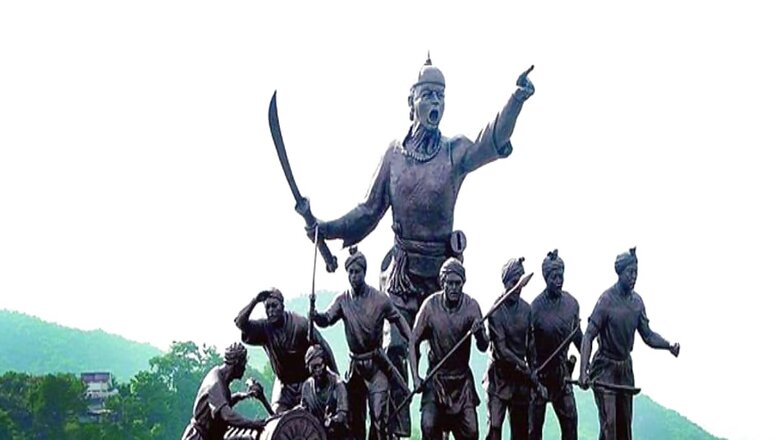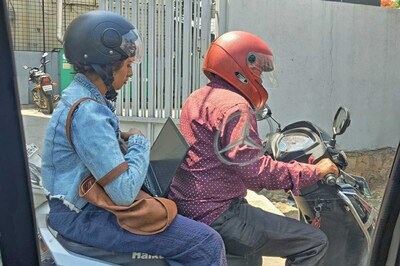
views
A compilation of over 42 lakh essays on the valorous Ahom general Lachit Borphukan has been recognised by the Guinness Book of World Records as the “largest online photo album of handwritten notes” and a letter recognising the same has been handed over to the Assam Chief Minister Himanta Biswa Sarma on March 10, 2023. This initiative as a part of the 400th birthday celebration of Lachit Borphukan is praiseworthy as it allowed an open public discourse. Such discourses create a multiplicity of narratives and often accommodate diverse ideations which can speak a lot about community identities and their redefinition. The perceived ‘core’ of the nation had a potential tendency of otherisation of the ‘periphery’ and there seems to have been a basic dissonance in the way in which the Indian governing structures went on to deal with popular aspirations, symbolisms at the level of the region till recent times.
Markers/Symbols Embodying Regional Identity
Institutional recognition of regional markers that embody regional identity, values and pride is crucial in the centre-periphery relations in the functioning of a federation. It embraces the plurality of the sources of identity, thus diverging from the popular perception of dominant mainstream political communities. PM Narendra Modi said, “We are privileged to celebrate the 400th birth anniversary of Veer Lachit at a time when the country is celebrating the ‘Amrit Mahotsav’ of its independence. This historic occasion is a glorious chapter in the history of Assam. I salute this great tradition on this festival of India’s immortal culture, valour and existence”, at the conclusion of the celebration.
The following steps have been taken to promote unsung hero Lachit Borphukan by the Union and the Assam governments.
- Since 1999, the Lachit Borphukan gold medal at the National Defence Academy (NDA) is given to the best cadet so that India’s brave soldiers can take inspiration from this warrior.
- The then President of India, Ram Nath Kovind, laid the foundation for a war memorial and a 150-foot bronze statue of the commander in Assam on February 25, 2022. Along with the statue, the memorial will also feature a 100-ft-long ‘Hengdang’ (Ahom sword).
- The Assam government announced the setting up of a museum to make the bravery saga of Veer Lachit Borphukan accessible to a greater number of people. The Assam government has also launched a theme song to connect people with this vision.
- The Prime Minister has suggested creating a grand theatre play on Lachit Borphukan on the lines of the one on Chhatrapati Shivaji Maharaj and taking that to every corner of the country, which would give a great boost to the resolution of ‘Ek Bharat, Shreshtha Bharat’.
Ahom Resistance against the Mughals
Assam is the only state in the Indian subcontinent to defeat the Mughal forces and not become a part of the Mughal political map. Assam defeated the Mughals 17 times which hardly finds any mention in any mainstream historical text. Lachit Borphukan was the man, who through his intrepid bravery, determination, war tactics and strategy repulsed the Mughals. The entire narrative is interesting regarding the revelations concerning the ramifications and the repercussions of the Mughal aggression in an uncharted territory. The entire episode of Ahom-Mughal relations involved a series of conflicts during the period of 1615-1682, beginning with the reign of Jahangir till the reign of Aurangzeb. The principal hostility can be grouped under two invasions by the Mughals, one under Mir Jumla and the other, under Raja Ram Singh. These two episodes have been preserved in a detailed and systematic record through contemporary eyewitness accounts of Fateha-i- Ibriyah and the Buranji (Ahom Court Chronicles) of Ram Singher Yuddhar Katha, respectively. Another very important source relating to the Ahom-Mughal conflict is Baharistan-i-Ghaybi, written by Alauddin Isfahani alias Mirza Nathan, which describes the plight of the Mughal soldiers on their invasion of the Eastern part of Hindustan. Mirza Nathan, also known as Shitab Khan, was the Faujdar of Kamrupa from 1612 to 1625.
To understand the conflict, an understanding of the political geography of Assam is essential. In the 17th century, the Ahom Kingdom extended from the river Manaha on the West to Sadiya on the East. Manaha was the recognised Eastern extremity of the Mughal empire. The Brahmaputra flowing from the East to the West divides Assam into the North bank and the South bank. The two main divisions from the West to the East were from Manaha to Kaliabor and the second one from Kaliabor to Sadiya.
Exploits of Mir Jumla and the Treaty of Ghilajharighat
One of the major military conflicts was in January 1662, during the reign of Jayadhwaj Singha, which is recorded in Fateha-i- Ibriyah by Shihabuddin Talish. This Persian account discusses in detail Mir Jumla’s invasion of Assam. Mir Jumla capitulated Garhgaon, though could retain it briefly and was able to conclude a humiliating treaty for the Ahoms on January 9, 1663, the Treaty of Ghilajharighat. The main reason of Jayadhwaj Singha’s defeat was due to defection in the Ahom camp, though this reason remains less discussed. Under the provisions of the treaty, the entire Western Assam (from Kaliabor to Guwahati) fell under the Mughals.
Background of the Battle of Saraighat: Revision of the humiliating treaty of Ghilajharighat
The background of the battle of Saraighat was the humiliating Treaty of Ghilajarighat in 1663, which, while returning Garhgaon back to the Ahoms, came at a heavy cost. After the death of Jayadhwaj Singha, his successor Chakradhwaj Singha could no longer bear the brunt of this humiliation. And a rigorous military training program and politico-military overhauling ensued. Preparations for war against the Mughals started and Lachit Borphukan was chosen as Assam’s man of destiny to lead the Ahom army against the invaders. He was the son of Momai Tamuli Barbarua, the first Barbarua under the Ahom King Pratap Singha. During the earliest phase of the wars with the Mughals, Momai Tamuli was appointed as the commander-in-chief of the Ahom forces. He was instrumental in signing the treaty of Asurar Ali with Allah Yar Khan in 1639, which fixed the Barnadi river as the boundary and formed the basis of Ahom-Mughal relations for decades to come.
War preparations were fully completed by the summer of 1667 and a fresh set of hostilities was about to begin. Ahom forces led by Lachit Borphukan stormed the Mughal bastions which resulted in a series of victories.
The alliances were renewed with the Jaintia and Kachari kingdoms and in August 1667, Lachit, accompanied by Atan Burhagohain, undertook a downstream expedition on Brahmaputra, to retake Guwahati, which was under the Mughals. Making Kaliabor his base camp, Lachit ensured Bahbari followed by Kajali, and Shah Buruj (Mani Karneswar) followed by Guwahati were recaptured by September 1667 while the entire region between Guwahati and Kapili river (Rangamahal, Itakhuli along with Umananda and Barhat) too was reconquered. Firuz Khan, the faujdar of Guwahati, was taken captive.
Mughal reinforcement under Raja Ram Singh of Amber
Alarmed at the losses, Aurangzeb sent a huge army under the command of Raja Ram Singh, son of the Amber Raja, Mirza Raja Jai Singh to retake Guwahati. By February 1669, Ram Singh reached Rangamati, accompanied by Rashid Khan and the Sikhs under Guru Tegh Bahadur. It was a massive army of 4,000 troopers, 30,000 infantrymen, 21 Rajput chiefs with their contingents, 18,000 cavalries, 2,000 archers and 40 ships. The Ahoms faced the Mughal army under Ram Singh at Alaboi, around August, 5, 1669 and the former faced some reverses. The next move of Ram Singh was opening negotiations for peace. But Atan Borgohain had warned Lachit Borphukon about the treacherous character of the Mughals and no treaty was signed. The Assamese also were tired of war and hostilities, and were suspended for a time. Soon after the battle of Alaboi, Chakradhwaj Singha died in 1669. He was succeeded by his brother Udayaditya Singha. During this period, Ram Singh proceeded further and laid a siege over Guwahati that led up to the final Battle of Saraighat in 1671, which the Ahoms won.
Ahom victory at Saraighat, 1671: A strategic battle theatre
The advances of the Mughal army were a grim signal of a critical situation. Here, Lachit Borphukan showed his tactical brilliance and superior warfare strategies. Knowing very well that the Ahoms had no chance in an open-field battle, he chose Guwahati with its hilly terrain. The only way up to Guwahati from the East was the Brahmaputra river. It was at Saraighat, where the Brahmaputra was at its narrowest point – just a width of 1 km – ideal for naval defence. While the Mughal army was the strongest on land, especially in open plains, their weakest point was their navy. Lachit Borphukan set up a series of mud embankments in Guwahati and ensured that the Mughals would be forced to take the river route to the city. He set up his headquarters at Andharubali, between Kamakhya and Sukreswsr hills to monitor the war operations. The small Ahom boats manoeuvred easily against the Mughal ships and the Mughals were finally pushed back to the West of the Manaha river. The battle of Saraighat fought in 1671 was the last determined attempt of Raja Ram Singh who met ignominious defeat at the hands of the Ahom army led by Lachit Borphukan. Rajput Raja Ram Singh would be praising his victorious adversary in the most gracious manner, ‘Glory to the Commander…One single individual leads all the forces. Even I, Ram Singh, could not find any loophole and an opportunity in his game plan to outdo him.”
The author is a senior faculty in the department of History, ARSD College, DU. She has done her MPhil, PhD program from Center for Historical Studies, JNU. Views expressed are personal.
Read all the Latest Opinions here

















Comments
0 comment